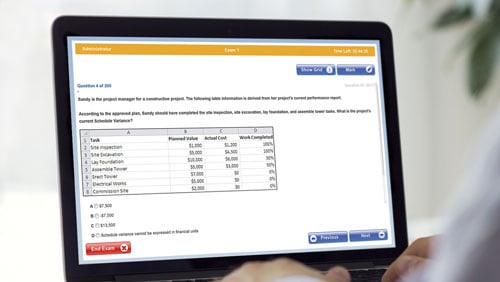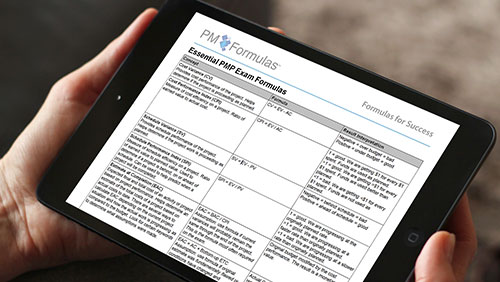10 Steps to Becoming a PMP®
Are you looking for a way to becoming a Project Management Professional (PMP)®? Look no further. Here are 10 steps that will show you how to become a certified project manager.

Let's jump right in!
- 1. Step 1: Read the Project Management Professional (PMP)® Credentials Handbook.
- 2. Step 2: Make sure that you are eligible to become a PMI certified project manager.
- 3. Step 3: Become a PMI Member & Member of your local PMI Chapter.
- 4. Step 4: Sign up for the PMP Exam.
- 5. Step 5: Study the PMBOK® Guide. Twice.
- 6. Step 6: Get a PMP Self-Study Course and Read a PMP Preparation Book.
- 7. Step 7: Take an In-Person PMP Workshop.
- 8. Step 8: Answer as many Sample PMP Exam Questions as you can.
- 9. Step 9: Study Hard and have a Plan.
- 10. Step 10: Take the Exam.
- 11. Step 11 (Bonus Step): Earn 60 PDUs every 3 Years.
Step 1: Read the Project Management Professional (PMP)® Credentials Handbook.
The Project Management Institute (PMI)® has published a Credentials Handbook (the Handbook), which you can find here. This Credentials Handbook explains everything that you want to know about the process of taking the PMP Exam and becoming PMI® certified project manager . Reading this Handbook takes about 20 minutes and it should be the first 20 minutes on your journey to becoming a certified PMP. It will answer most of your questions about the procedures for applying and taking the exam.
Step 2: Make sure that you are eligible to become a PMI certified project manager.
It is really quite simple to find out if you are eligible or not to take the PMP® Exam.
Do you have a high school diploma, an associate degree, or the global equivalent of these? Then you must have a minimum of five years (60 months) of unique, non-overlapping professional project management experience of which at least 7,500 hours must have been spent leading and directing project tasks. (Non-overlapping means that if you managed two projects in the last year, then that only counts as 12 months and not as 24.)
Do you have a bachelor degree or its equivalent in your country? Then you must have a minimum of three years (36 months) of unique, non-overlapping professional project management experience of which at least 4,500 hours must have been spent leading and directing project tasks.
In both cases, you must also show that you have had 35 contact hours of project management training. The good news is that all project management related training from your entire life counts. So, if you are 30 years old and you took a 2-day PM class when you were 21 years old then you already have 16 contact hours. (One contact hour is equivalent to one actual hour (60 minutes) of training or instruction received.)
Step 3: Become a PMI Member & Member of your local PMI Chapter.
Becoming a member of the PMI makes financial sense because as a PMI member you will not only receive a free PDF version of A Guide to the Project Management Body of Knowledge (PMBOK® Guide) but you will also receive a substantial discount on the PMP® Exam. In fact, the discount is bigger than the membership fee! So even if you don't want to stay a PMI member for life, becoming a member in your first year makes sense.
Becoming a member of your local PMI Chapter can also make sense because most chapters offer PMP Prep Workshops. Again, as a member you usually receive a discount that is greater than the membership fee. Your local chapter is also a great resource for PMP information. You can attend your chapter's dinner meeting and speak in-person with new and seasoned PMPs about the exam. They will be very happy to answer your questions and help you. You will also have a chance to meet PMP aspirants like yourself and you can form a study group. Studying together is more fun and increases your chance of passing.
Step 4: Sign up for the PMP Exam.
"I want to become a PMP" is a good plan. But "I want to become a PMP and my exam date is in 3 months" is a much better plan because we all work a lot better when we have a deadline.
Start by visiting https://certification.pmi.org to register. Then you fill in your online PMP Credential Application and submit it to PMI for approval, after which they will issue a confirmation number. Now you can schedule to take the exam on the Prometric Website at https://www.prometric.com/PMI.
This separate scheduling is necessary because PMI doesn't perform the test themselves — instead they use Thomson Prometric, a testing company with testing centers around the world. Depending on where you live you may have to travel quite far to take the exam. As a result, you definitely want to schedule this well in advance.
Step 5: Study the PMBOK® Guide. Twice.
The PMBOK® Guide is the primary reference used on the PMP Exam. Most trainers estimate that the correct answer for roughly 75 percent of the questions on the PMP Exam can be found in the PMBOK® Guide. Therefore you must know it inside and out, and the only way to know it is to study it at least twice.
Step 6: Get a PMP Self-Study Course and Read a PMP Preparation Book.
There are many very good self-study courses and PMP Preparation Books available. We offer our very own PM PrepCast for PMP Exam Prep, and you can find the books on Amazon, or in your local bookstore. These study resources resources will teach you the 25 percent of additional material that you cannot find in the PMBOK® Guide.
And because the PMBOK® Guide is so "dry", these third-party products will help you understand what the PMBOK® Guide is trying to say. They will "translate" the concepts, tools, and techniques from the guide and give you examples from everyday PM life to show you what is meant.
Most self-study courses (including The PM PrepCast) will also give you a certificate for the PMI-required 35 contact hours — the books cannot offer that benefit.
For more tips about the essential PMP exam study materials you'll need, watch this short video:
Step 7: Take an In-Person PMP Workshop.
PMI Chapters, universities, colleges, and training companies offer a number of in-person PMP workshops around the world. They usually last from 2-6 days. Some of them require that you study for yourself in addition to the course and others don't. Some companies even offer a passing guarantee. But don't be fooled. This guarantee is just marketing and their risk is very low. After all, would you intentionally fail the exam just so that you can take their course again?
If you are lucky then your employer may offer to pay for a workshop. If you have to pay for it yourself then look into the course that is offered by your local PMI Chapter because they are usually very affordable. Just like the self-study courses and books, the classroom training will help you understand the PMBOK® Guide. The benefit here is that you will have an instructor and other students to help you understand particularly difficult sections like earned value or risk from the PMBOK® Guide. Don't be afraid to ask questions.
If your budget allows then we recommend using both a self-study course combined with an in-person workshop to achieve the best study result.
Obviously, a self-study course or a PMP workhop will lead to exam success on their own. But there no denying that combining the two will give you an effective one-two punch to boost your studies.
Step 8: Answer as many Sample PMP Exam Questions as you can.
When it comes to free sample questions, you get what you pay for. Free is good to get an idea and most people do. But you will have to pay for "real" questions from a reputable online PMP Exam Simulator. Sample questions are also available in books so you can go down to your local bookshop and take some time to look through the questions in the books before you decide which one to buy. However, only a simulator will allow you to test yourself in exam-like conditions -- you can take a complete, 4-hour exam at the computer. Just like the real thing.
As you make your way through all the free samples that you find online two things will happen:
- First, you will get used to answering exam questions, which is good; and
- Second, you will begin to disagree with some of the suggested answers, which is even better.
By disagreeing and then opening up your study materials to review you will learn even more. Therefore, even the worst exam sample question that you can find can help you in its unique way to pass the exam. It's all a matter of your personal attitude and knowing that even a bad question can take you further.
One last but important thing about sample questions: keep track of your score. As time goes by you will notice that you are more and more able to answer questions correctly. If you keep your score then you can see where you are. Here is rule of thumb for you: if you consistently answer 85 percent of the questions correctly the first time that you answer them, then you are ready to take the exam.
Step 9: Study Hard and have a Plan.
Studying for the PMP Exam is a serious endeavor and requires personal dedication. Manage your road to becoming a PMP like a project and create a plan — a PMP Study Plan. In this plan, define how many hours you will study every day, how many chapters you will read, and how many sample questions you will answer. Having a good plan is the start. Then you will also have to tell your family and friends about it. That way they know that you will be "gone" at times for the next 2-3 months to prepare. But don't overdo it. You should plan on having breaks and leisure time as well. You need variety in your life so don't forget to go and see a movie every now and then or have a drink with your friends.
Be prepared for ups and downs during your studies. Some sections of the PMBOK® Guide will be easy for you and you’ll feel great. Then there are those sections that are more difficult because you don't have any experience. Don't despair. Don't think that you are never going to understand this. Thousands of people have passed the exam before you and you can pass it too! Stay positive at all times. You will achieve your goal of becoming a PMP.
Step 10: Take the Exam.
After all that hard work, taking the exam almost sounds like the easy part. But there are a few things to consider that will help you to make this a positive and successful experience for you.
Try and get a good night's sleep the night before the exam. Being refreshed and having slept enough is important. There is no need for you to study the night before the exam and stay up until 3 a.m. You have studied long and hard and you are now ready for this — so get some sleep. A lot of people choose to take the day of the actual exam off from work. You can sleep in, eat a good breakfast, go for a walk, and relax. That way you won’t be too nervous when you get to the testing center. It is a good idea to take a test drive to the testing center a week beforehand so that you know where it is. You may also want to try and arrive one hour early just in case you miss the bus or have car problems.
Here is what you should bring with you to the testing center:
- Two forms of official identification with a photo
- Water and some snacks
- A sweater or light jacket
- Foam earplugs because it could be noisy
Before the exam starts there is a short tutorial that explains how to use the computer and software. Don't skip it. There is important information in the tutorial. If you take the tutorial, then you can be sure that you understand everything and don't make any mistakes because you made assumptions.
Now click the "Start Exam" button. Good luck!
Step 11 (Bonus Step): Earn 60 PDUs every 3 Years.
Congratulations! You have achieved your goal to becoming a certified project manager! You've got that PMP behind your name as soon as you pass the exam. There is no waiting period. As soon as you see "Passed" on the screen you hold the PMP certification. Go home and send an email to all your friends and colleagues and tell them that you are now a PMP. Celebrate!
However, you are not a PMP for life!
Every three years you will need to collect and claim Professional Development Units (PDUs) to keep the certification active. You will need 60 PDUs every three years to recertify and the details are explained in PMI's Continuing Certification Requirements (CCR) Handbook. You can earn PDUs by attending local PMI Chapter dinner meetings, by volunteering for PMI, or by attending seminars offered by PMI Registered Education Providers (R.E.P.).
The good news is that there are many ways to earn free PDUs. Our favorite are podcasts! And among among podcasts there is no better than The Project Management Podcast which will give you a total of 60 Free PDUs.


